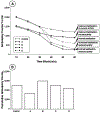Recommendations for harmonization of data collection and analysis of developmental neurotoxicity endpoints in regulatory guideline studies: Proceedings of workshops presented at Society of Toxicology and joint Teratology Society and Neurobehavioral Teratology Society meetings
- PMID: 28757310
- PMCID: PMC6634984
- DOI: 10.1016/j.ntt.2017.07.001
Recommendations for harmonization of data collection and analysis of developmental neurotoxicity endpoints in regulatory guideline studies: Proceedings of workshops presented at Society of Toxicology and joint Teratology Society and Neurobehavioral Teratology Society meetings
Abstract
The potential for developmental neurotoxicity (DNT) of environmental chemicals may be evaluated using specific test guidelines from the US Environmental Protection Agency or the Organisation for Economic Cooperation and Development (OECD). These guidelines generate neurobehavioral, neuropathological, and morphometric data that are evaluated by regulatory agencies globally. Data from these DNT guideline studies, or the more recent OECD extended one-generation reproductive toxicity guideline, play a pivotal role in children's health risk assessment in different world areas. Data from the same study may be interpreted differently by regulatory authorities in different countries resulting in inconsistent evaluations that may lead to inconsistencies in risk assessment decisions internationally, resulting in regional differences in public health protection or in commercial trade barriers. These issues of data interpretation and reporting are also relevant to juvenile and pre-postnatal studies conducted more routinely for pharmaceuticals and veterinary medicines. There is a need for development of recommendations geared toward the operational needs of the regulatory scientific reviewers who apply these studies in risk assessments, as well as the scientists who generate DNT data sets. The workshops summarized here draw upon the experience of the authors representing government, industry, contract research organizations, and academia to discuss the scientific issues that have emerged from diverse regulatory evaluations. Although various regulatory bodies have different risk management decisions and labeling requirements that are difficult to harmonize, the workshops provided an opportunity to work toward more harmonized scientific approaches for evaluating DNT data within the context of different regulatory frameworks. Five speakers and their coauthors with neurotoxicology, neuropathology, and regulatory toxicology expertise discussed issues of variability, data reporting and analysis, and expectations in DNT data that are encountered by regulatory authorities. In addition, principles for harmonized evaluation of data were suggested using guideline DNT data as case studies.
Keywords: Behavior; Developmental neurotoxicity testing; Extended one-generation reproductive toxicity; Learning and memory; Morphometry; Neuropathology.
Copyright © 2017. Published by Elsevier Inc.
Conflict of interest statement
Conflict of interest
Drs. Bolon, Garman, Hofstra, Hoberman, Kaufmann, Lau, Li, Sheets and Vidmar were employed or funded by companies that conduct studies that may have DNT-like endpoints for regulatory submission.
Figures








Similar articles
-
Developmental neurotoxicity guideline study: issues with methodology, evaluation and regulation.Congenit Anom (Kyoto). 2012 Sep;52(3):122-8. doi: 10.1111/j.1741-4520.2012.00374.x. Congenit Anom (Kyoto). 2012. PMID: 22925212 Review.
-
Comments from the Developmental Neurotoxicology Committee of the Japanese Teratology Society on the OECD Guideline for the Testing of Chemicals, Proposal for a New Guideline 426, Developmental Neurotoxicity Study, Draft Document (October 2006 version), and on the Draft Document of the Retrospective Performance Assessment of the Draft Test Guideline 426 on Developmental Neurotoxicity.Congenit Anom (Kyoto). 2007 Jun;47(2):74-6. doi: 10.1111/j.1741-4520.2007.00148.x. Congenit Anom (Kyoto). 2007. PMID: 17504392
-
International Regulatory and Scientific Effort for Improved Developmental Neurotoxicity Testing.Toxicol Sci. 2019 Jan 1;167(1):45-57. doi: 10.1093/toxsci/kfy211. Toxicol Sci. 2019. PMID: 30476307
-
Developmental neurotoxicity testing: scientific approaches towards the next generation to protect the developing nervous system of children. An overview of the Developmental Neurotoxicity Symposium in 2011.Congenit Anom (Kyoto). 2012 Sep;52(3):119-21. doi: 10.1111/j.1741-4520.2012.00366.x. Congenit Anom (Kyoto). 2012. PMID: 22925211
-
A retrospective performance assessment of the developmental neurotoxicity study in support of OECD test guideline 426.Environ Health Perspect. 2009 Jan;117(1):17-25. doi: 10.1289/ehp.11447. Epub 2008 Aug 12. Environ Health Perspect. 2009. PMID: 19165382 Free PMC article. Review.
Cited by
-
Orally administered branaplam does not impact neurogenesis in juvenile mice, rats, and dogs.Biol Open. 2021 Oct 15;10(10):bio058551. doi: 10.1242/bio.058551. Epub 2021 Oct 28. Biol Open. 2021. PMID: 34528068 Free PMC article.
-
Assessment of developmental neurotoxicology-associated alterations in neuronal architecture and function using Caenorhabditis elegans.bioRxiv [Preprint]. 2025 Jan 14:2025.01.11.632560. doi: 10.1101/2025.01.11.632560. bioRxiv. 2025. Update in: ALTEX. 2025 Apr 23. doi: 10.14573/altex.2501151. PMID: 39868199 Free PMC article. Updated. Preprint.
-
Achieving CLARITY on bisphenol A, brain and behaviour.J Neuroendocrinol. 2020 Jan;32(1):e12730. doi: 10.1111/jne.12730. Epub 2019 May 26. J Neuroendocrinol. 2020. PMID: 31063678 Free PMC article. Review.
-
Delta Opioid Peptide [d-Ala2, d-Leu5]-Enkephalin Improves Physical and Cognitive Function and Increases Lifespan in Aged Female Mice.Mol Neurobiol. 2025 Mar;62(3):3568-3582. doi: 10.1007/s12035-024-04503-y. Epub 2024 Sep 23. Mol Neurobiol. 2025. PMID: 39312071
-
Assessment of developmental neurotoxicology-associated alterations in neuronal architecture and function using Caenorhabditis elegans.ALTEX. 2025 Apr 23:10.14573/altex.2501151. doi: 10.14573/altex.2501151. Online ahead of print. ALTEX. 2025. PMID: 40302409 Free PMC article.
References
-
- Altman J, Sudarshan K, 1975. Postnatal development of locomotion in the laboratory rat. Anim. Behav 23, 896–920. - PubMed
-
- Barnes D, Altman J, 1973. Effects of two levels of gestational-lactational undernutrition on the postweaning growth of the rat cerebellum. Exp. Neurol 38 (3), 420–428. - PubMed
-
- Blokland A, Rutten K, Prickaerts J, 2006. Analysis of spatial orientation strategies of male and female Wistar rats in a Morris water escape task. Behav. Brain Res 171, 216–224. - PubMed
-
- Bolles RC, Woods PJ, 1987. The ontogeny of behaviour in the albino rat, limb of the neonatal rat. J. Physiol. Lond 383, 79–92. - PubMed
MeSH terms
Grants and funding
LinkOut - more resources
Full Text Sources
Other Literature Sources

